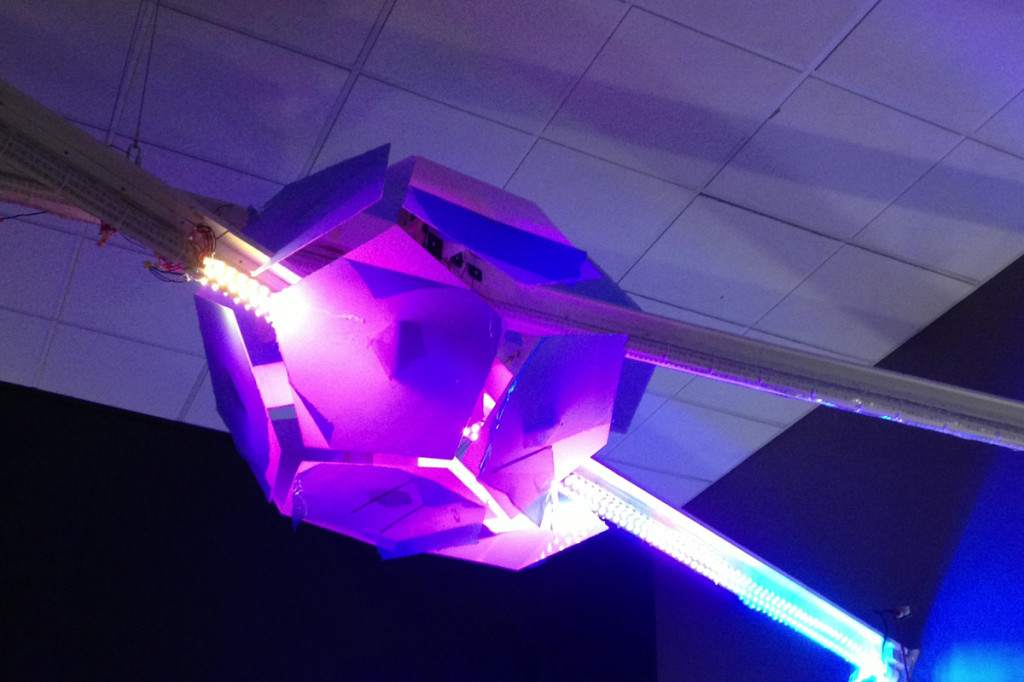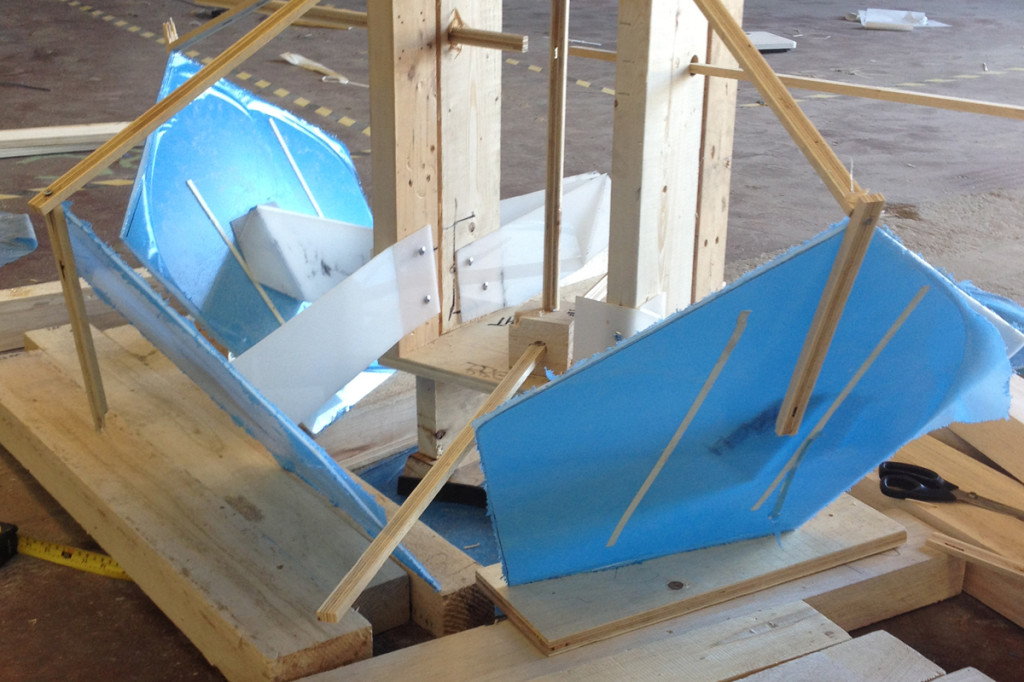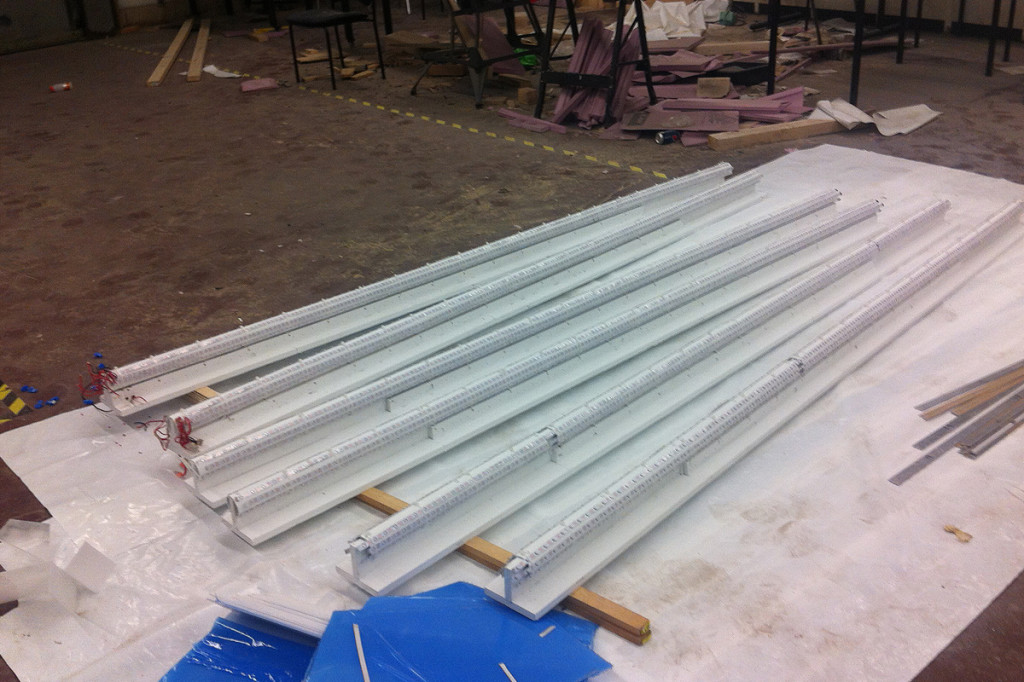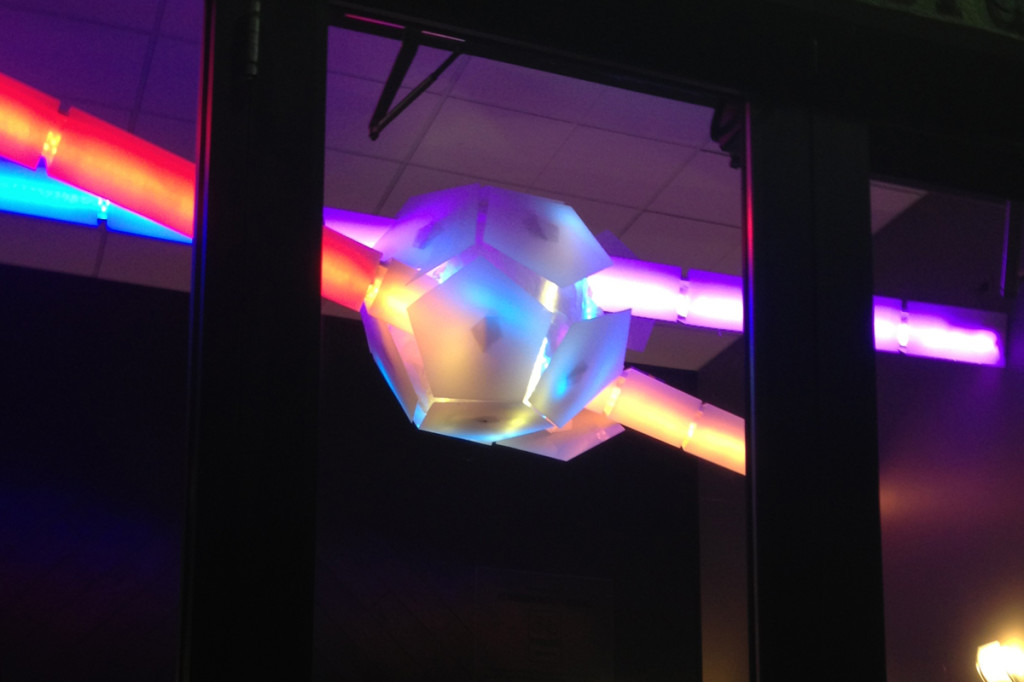We figured it would best to have all creators’ perspectives in this last post about this project, and so it will be split into three following sections (please click on the links to go to each respective section):
- Anthony’s final thoughts “The End”
- Henri’s building processes “”On the Right Path”
- Kevin and what it is like to work on this project “Overcoming Obstacles”
Also, for completions sake, our previous posts can be found here:
• Anthony Scavarelli
Here we are finally at the end. “Paths” has been a great but enduring experience with so many seemingly conflicting notions trying to tear the process apart: the known vs. the unknown, screen-based vs. physical, open vs. closed, budget vs. ambition, and concept vs. reality. Fortunately, the project really came together – a great learning and growing experience that we will indefinitely cherish.
Early on we decided that we wanted to create something with impact in a manner that did not hit prospective visitors over the head with technology for the sake of technology. It had to be something that was unusual, but also something that would suit the space and context. It was a few weeks after deciding upon a physical installation that the more tangible concept of “Paths” was born. From the first moment you walk into the Invest Ottawa lobby we imagine that you will first ‘see’ (a light sculpture that was built to fit the space), then ‘hear’ (the voices emanating from the walls), to finally ‘interact’ (notice your movement through the doors or under the installation changes the light patterns). “Paths” was constructed with nuanced levels in mind – that it was not all immediately understood or experienced until after a few visits; such as perhaps one noticing only moving light at first, then in subsequent visits noticing the voices in the walls and interaction, and finally, perhaps farther in the future, that certain hashtags to Invest Ottawa’s Twitter account affected it more than others. It is admittedly a lot to desire – wanting to draw out the visitors exploration of the piece over weeks as opposed to moments – and though we obliged towards succinct concepts it inevitably became a sum of its many moving parts. It was when considering these many parts that it quickly became apparent that before we could “paint”(program the look and feel) we would first need to make and put all those pieces together to create the “canvas”, the structure. You will find great detail on the construction of this piece within Henri’s thoughts below, and from there an interesting third-party view into Henri and I’s no doubt strange and imperfect manners of concept and ultimately creation in our student assistant Kevin’s account following that. We hope that these posts may prove insightful; but if there are any questions, or lack of clarity you wish addressed, please don’t hesitate to send an email or comment below.
Thanks to all those that have helped make this project possible, and to all those that have followed it from the beginnings. To our friends and family for enduring with us the long nights, and finally to the open-source movements from which we learned so much. In the new age of self-learning the selfless and open individuals that contribute to the open-source movements provide for us all the archetype of how we can all “stand on the shoulders of giants” to greater aspirations. Similarly to the open-source ideals no one individual can lay claim to “Paths” in creation either – it was truly a team effort that would not have been possible without Henri, Kevin, The City of Ottawa, Invest Ottawa, Algonquin College, Artengine and many others.
We hope you find the project interesting, and even with so much effort involved we personally look forward to the next one.
• Henri Kuschkowitz
It’s been a long time coming, but with months in preparation and numerous known (and unknown) issues overcome Anthony and I were able to complete our biggest to date project and it’s a beaut. To me it represents a journey of exploration, endeavor and overcoming obstacles that have provided us with many useful insights to guide us better in the future. Below I will guide you through the timeline of events from my perspective starting at the point we left off in the last post.
From Virtual into Physical
After sketching and modeling many various prototypes for the final art piece we envisioned for the space I was more than thrilled to get my eyes away from the screen and my hands dirty. At the start of the project I prepared an architectural model of the space with the intend to provide a better feel for the space and to test our possible designs, but nothing compares to the excitement (and pride) I was experiencing when completing an additional step of the fabrication of all the pieces.
This was a welcoming boost in confidence as the masses of email communications to find products and solutions, doubts that started to grow with every day waiting for the go ahead from our stakeholders and reassuring Anthony that staying on track with Plan ‘A’ is the right choice had taken a toll on my moral as well.
I can’t always say that things come at the right moment, but starting to fabricate couldn’t have happened at a better time. Well, technically that is not true since we were running roughly two and a half weeks late from our initial schedule due to the struggles mentioned in the previous post. We were able to have Peter Schmelzer, the gallery technician and all around handyman, come and help us prepare the lobby space but he then went on vacation which ultimately meant that unless we wanted to postpone the production at least another week and a half to be able to get the support and skill from him, I would have to take matters into my own hands, literally. Unfortunately, there was a second variable to this equation, purchasing the actual materials. As a city contractor, Peter would have been able to purchase most of the items on their behalf but since he was not available we ended up having to pay up front for most things, including renting equipment and building supplies, out of our own pocket and would then have to keep track of all receipts and invoice the city later. We never had to worry about coordinating our business expenses for a project like this before but I realized that it would be of major benefit to have a system in place for such circumstances, a.k.a. a business loan from legal lenders. By the way, legal money lenders are no different from banks these days. Likely, this will be a full-fleshed adventure of its’ own…
After two maxed out credit cards and one half way through, we finally had all the parts we could not get locally ordered and the rest purchased from the friendly neighborhood chain, Home Depot.
Despite all these issues, the optimist in me took the given circumstance to see the upside in what had presented itself for the foreseeable future. At this point, I had already managed to coordinate with John Omura, Project Manager of Applied Research & Innovation at Algonquin College, to have access to space in one of their workshops. Peter was kind enough to let me borrow a few of his tools that would be essential in fabricating many pieces of the installation, and one of the ModLab guys came through in helping me find a power converter to use with a custom-built acrylic bending machine.
Around this time, I also came across nitobi.com while researching efficient development frameworks for a side component of the project. The site’s resources on mobile and web applications intrigued me, especially considering the need for a streamlined way to document and present our work. Although our primary focus was on the physical installation, the idea of integrating a digital element to showcase our progress became an interesting possibility.
Furthermore, we were fortunate that at the time, a group of students was occupying another space in the workshop, and through a few chats, we came to an agreement to share tools with each other, which turned out to be tremendously helpful at times, as Kevin will likely attest. The next week was spent from 8 AM in the morning to nights up to 3 o’clock, working in the shop to try to catch up on as much lost time as possible. Even though these days were long, it was encouraging to get up early again the next day just because I could see the progress and remainder of the project—a benefit that is not always as evident when coding.
The Art of Cutting and Bending Acrylics
When we started our research of possible materials for our installation’s “shell”, the visible outside pieces, we approached local fabricators. I was disappointed by most businesses as they would either avoid returning my emails (even after visiting in person) or overcharging me for materials and possible services. We finally found a supplier in Ottawa, Sabic Plastics, to be more than helpful and forth coming. Not only did they offer materials at a friction of the cost, our point of contact was friendly enough to cut acrylic sheets based on our requirements at no additional cost saving us valuable time. He was even able to provide us with other materials for testing free of charge of which Canus Plastics previously welcomingly invoiced us including scraps no one could use for any real purposes. However, Sabic would not be able to fabricate the acrylics to the shape we needed them to be so I had to come up with an alternative. I decided to build my own machine to heat a narrow six feet long edge to approx. 900 degrees Celsius. I had reviewed other projects and was able to work out a functioning setup using Nichrome wire and down converter [check] and a regular household dimmer switch (the ones that go in the wall controlling lights).
This setup would work for most of the pieces until the converter overheated in a plume of smoke. I was able to make the setup work with only a dimmer switch to control the 120V current running through one end of the wire to the other. It took very precise controlling to ensure the wire would not overheat but it worked out for the rest of the project. Kevin and I both did managed to melt the wire once by being overly liberal with the dimmer switch, but I was able to salvage the mistakes fairly quickly and moved on (thank you Home Depot for the endless supply of dimmer switches).
A Festival of Lights
Another part of the project I was eager to see was having all the strings of LEDs successfully light up on the sections of beams that we previously build which would be then connected on site. In order to achieve this, we needed to solder six strings of LEDs together which proved to be as much fun as it sounds using 14 gauge wiring (particularly for Kevin). After many loose connections and wiring ripping off the string we were able to finish the process and finally see some beautiful test patterns burn through the backs of our skull, something we knew 3000 LEDs would do, but needed to experience either way. It was time to mount all our strips on the beams that we had prepared and align them properly. We decided to use zip ties and small amounts of hot glue when needed to keep everything in place. This was not ideal as during transportation, installation and testing on site the strings would frequently shift out of place, but we wanted to not use the adhesive on the back of the strings to make it easier for them to be reused by the city for future projects. Connecting the cabling of each strip to one another became fairly cumbersome as well but it was an important process to ensure no LED would be covered by them. Additionally, once having every lit I needed to replace broken LEDs at a few places down the strips, a process that was expected from the beginning. I had decided to go with thicker cabling for powering the lights, coaxial cable for sending data over longer distances and quality power supplies to ensure everything would work reasonably.
Throughout this process it became clear that our research well paid off in terms of saving cost, time and energy.
A Dodecahedron, an Orb, … the Nucleus
With time running out this shape, as beautiful as it is, proofed to be tricky to fabricate due to the brackets that were needed to hold each side individually on the internal structure. Anthony had thought out this shape to break off on one side which turned out to be a godsend as with every additional face installed it became harder and harder to reach the mounting brackets that needed to be attached. I had to improvise on how to hold all pieces in place while reviewing the next piece to mount but it all came together just in time to transport all the segments back to Invest Ottawa.
Just like LEGO
As I mentioned before, things sometimes come together just at the right time. It turned out that just in the nick of time I had to purchase a new car that happen to come with a roof rack ideal to transport the long beam sections back to Invest Ottawa. Additionally, I aimed to have the work completed to have Peter scheduled as soon as possible to help mount the sections in place. He was able to prepare the space enough by the time I arrived with all the pieces to combine the beam sections and install them in place. After this step was completed, Anthony and I took over and mounted the nucleus one piece at the time and made modifications were needed to fit everything together perfectly. The weeks that followed I installed power supplies and related cabling and went on to test the LEDs as a whole as well as the audio components we were able to purchase through Invest Ottawa directly. At this point I should mention how important it is to make sure that the wiring from the controller to the LEDs needs to be spotless. I spent countless hours trouble shooting spotty lights just to realize that the coaxial cable shielding had a few strands remaining that were touching the controller’s pins that were sending out the information to the LEDs and once removed things were starting to look de-light-ful (pun intended). Since we both were worried about additional strain to our bank accounts, it was a pleasant surprise how quickly this entire transaction took place. Mind you, we could have not purchased the other material through Invest Ottawa as we needed to spend the city’s budget first.
We then moved along at a steady pace installing all outside acrylic paneling that I previously fabricated. Because of the budget constrains we were experiencing we scrammed weeks before to cut down costs as much as possible. Doing so, we shrank the size of the acrylic paneling for the beams as well as the nucleus, which left us now with undesirable side effects we had to accommodate. If the panels on the beams wouldn’t be placed precisely they would not diffuse the LEDs enough to wash together. Though I think the effect is negligent to a passerby, it does bug me as the perfectionist in me is coming through. Additionally, we decided to enhance the look of the bare LEDs that can be seen between panel sections by adding layers of diffusing material over them. This meant that we would have to remove all paneling again to be able to easily access the beams themselves using staple guns. For future reference, vigorous testing will help avoid these confusions.
We were finally coming to a finish with the physical installation process and only needed to add lighting to the center of the nucleus and mounting all environment sensors in place. I was originally worried about how long it would take to create a an support structure within the nucleus onto which we would mount more lights, but with Anthony’s regained confidence and some successful brainstorming we were able to wrap this step of the construction up in only a few hours.
The Final Push
We were now much behind schedule and I am thankful that Invest Ottawa had been patient enough for us to use their office space longer than intend as well as the building owner, Epic Realty, with the scaffolding and materials we needed to leave within the lobby space. The piece that now remained was fine-tuning sensors and light patterns which will be finished today or tomorrow.
We were glad that we had the opportunity to already present the functioning piece to the staff of Invest Ottawa last week, mainly to showcase that everything after months in development was finally coming to a close but also to highlight the involvement many of the team had with this project. Most of them were involved at some point or another, whether it was advising us on concepts, suppliers and possible opportunities or letting us capture their voice, which we are now using as part of the art piece.
Conclusion
Needless to say, we have gained many useful insights, tools and knowledge that will guide us in our next projects and I am incredibly thankful for having had the opportunity to work on such a project. The help and support we have gotten from all involved parties (and beyond) has been reassuring that the interest to create more creative environments within the city is there. Though I would be lying if I wouldn’t mention that at times the amount of input we received was overwhelming, too. We had to manage expectations, address issue that arose half way through the process that cost us valuable time and energy. Though, I think that this is probably something that everyone involved was expecting to a certain extend since we were part of a pilot project where all parties were learning what to expect throughout the process.
It is now up to us to move forward and seek new opportunities that will let us share our believes of openness, engagement and collaboration with the community and local businesses through creative experiences.
• Kevin Schaeken
Over the course of the summer I’ve had the opportunity to work with The Luminartists on the Invest Ottawa Residency project as their student assistant. I went into the job knowing that I could be handling various tasks from programming to actually creating the installation, but nothing could really prepare me for what was in store. Every week felt like I was learning a new skill and Anthony Scavarelli definitely put me to use whenever there was a task that needed to be done. The summer has reached its end and I have now gained additional skills and a few new friends.
For those looking for a background of what this project entails you can read the previous blog posts right here.
Finding One’s Path
The first half of the summer was spent with Anthony and I working on the virtual prototype and researching where we could find materials for the installation. Breaking down the list of items that we needed was a challenge as this was my first art installation. It took some time to find the right suppliers, while trying to keep things as local as we could. Searching the web became a larger task than expected for a few days. In regards to programming Anthony allowed me to touch up on my Processing skills and learn how to use Cinder for the first time.
Tales That Grow
Most of my contribution can be found in the audio work. I scheduled several days of interviews and recordings. I had the pleasure to hear stories from the President of Invest Ottawa as well as other employees and the entrepreneurs who use the IO space daily. There are a lot of rich content that can inspire anyone to start their businesses in Ottawa. I have to thank Affinity Productions for helping us with the audio equipment that best worked in our situation. Invest Ottawa became a recording studio for a few days and it was a lot of fun.
I cleaned up the audio using Adobe Audition and sliced up the interviews into different topics. This way you can hear various voices in the lobby talk about on specific topic. I then used an FMOD Ex audio library for Cinder that allowed us to place different voices in each corner of the lobby space. This
way you can walk to one corner and hear one interview more clearly then the others. It really creates a buzz in the room and helps to make the space alive.
Late Nights Jams
Moving into the physical installation phase I worked with Henri Kuschkowitz for the later half of the summer at Algonquin College. We work many long nights in the workshop as we blasted tunes till the early morning just to do it all again a few hours later. I was given the chance to work on some new machinery and produced various pieces of the installation. One of the most fascinating parts of the summer was witnessing the artistry of creating something so articulate out of basic supplies such as ABS tubes and plywood.
Growth Through Others
Now that the summer is over I can say that I have learned so much more in regards to big scale projects and what each step entails. It was a privilege to work with Anthony and Henri. I wouldn’t hesitate if they asked me to work together again. It’s fun to work on a project that interests you but the people you work with is the icing on the cake.
Tags: art, installation, interactive, invest ottawa, Post-Mortem







